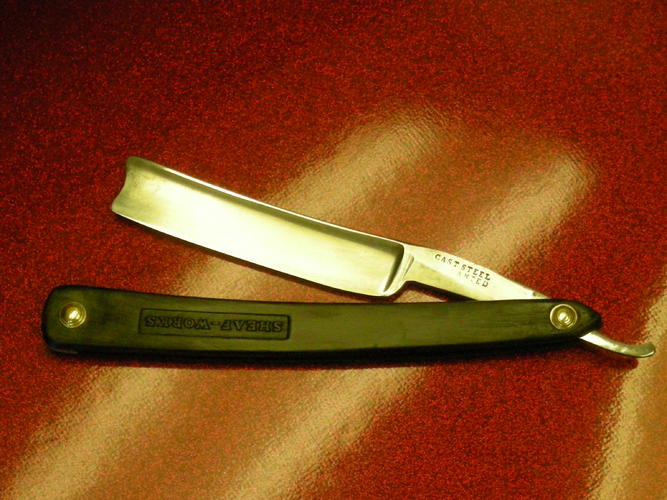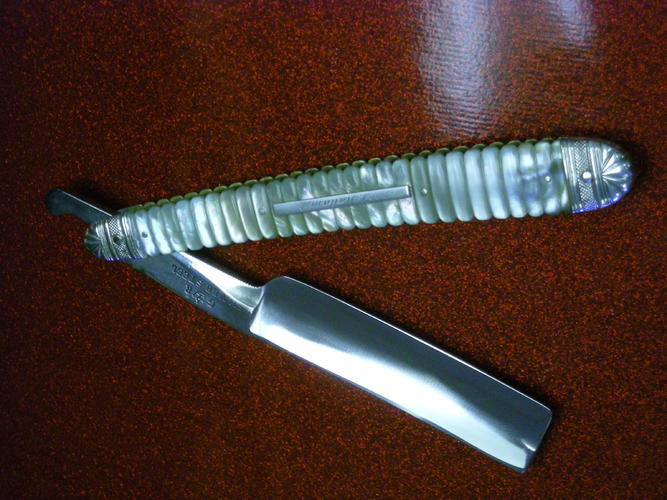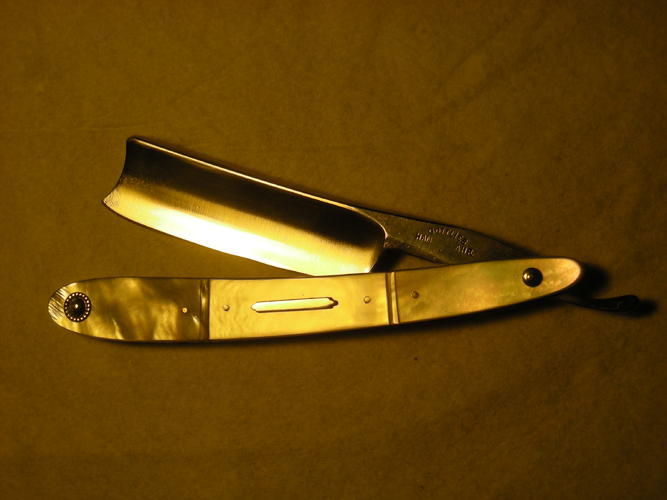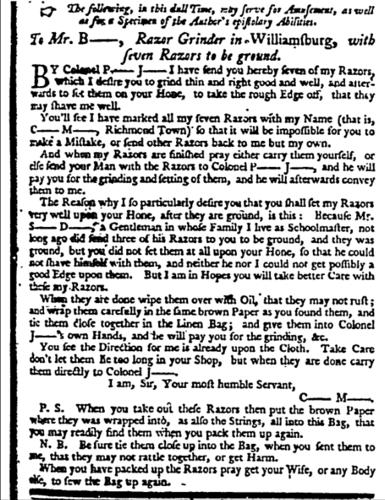Results 1 to 10 of 16
Thread: The Master Regrind Revisited
Hybrid View
-
08-20-2013, 12:04 PM #1
 The Master Regrind Revisited
The Master Regrind Revisited
In another thread posted by Sharptonn about his W&B Chort Chop he said the the regrind was done by a master. I am wondering, since this apparently was common (or was it) to regrind a big blade, what makes a master regrind? And what makes for a less than master regrind? And when is is necessary to regrind?
"Call me Ishmael"
CUTS LANE WOOL HAIR LIKE A Saus-AGE!
-
08-20-2013, 12:15 PM #2Senior Member



- Join Date
- Dec 2011
- Location
- I'm Gonna Spend Another Fall In Philadelphia
- Posts
- 2,029
Thanked: 498
I'm assuming when Tom said a Master reground it. He referred to a professional razor grinder a man who does nothing but grinds razors all day every day (many moons ago). As far as when its necessary. When hollow grinds started to come into fashion many people liked the shave and wanted to have that hollow grind type razor. So a lot of the big wedges were converted to hollow grinds. I'm sure the conversion was a lot cheaper then the purchase of a new razor.
-
The Following User Says Thank You to Tarkus For This Useful Post:
WW243 (08-20-2013)
-
08-20-2013, 12:45 PM #3Senior Member



- Join Date
- Dec 2011
- Location
- I'm Gonna Spend Another Fall In Philadelphia
- Posts
- 2,029
Thanked: 498
One further thing. I'm sure all the English razor makers watched in horror as they saw there sales drop from the German influx of hollow ground razors. I'm sure the English makers had shelves of finished wedges that were taken down and reground before ever leaving the factory, in order to keep sales moving.
-
The Following User Says Thank You to Tarkus For This Useful Post:
WW243 (08-20-2013)
-
08-20-2013, 01:51 PM #4
 "Call me Ishmael"
"Call me Ishmael"
CUTS LANE WOOL HAIR LIKE A Saus-AGE!
-
08-20-2013, 02:55 PM #5Senior Member



- Join Date
- Oct 2010
- Posts
- 26,211
Thanked: 8626
If you see a hollow grind on a very old blade, esp if it has a stabilizer, it has probably been reground, esp if you see the same blade in wedge configuration which has not! Also, grinding striations will be seen as they were usually not polished to the degree of factory razors.
Lots of guys consider them un-original and worthless, but I seek them out, personally.
If you get one properly done, they are sweet!


 Nothing more to say........
Nothing more to say........
-
The Following User Says Thank You to sharptonn For This Useful Post:
WW243 (08-20-2013)
-
08-20-2013, 03:12 PM #6Senior Member



- Join Date
- Dec 2011
- Location
- I'm Gonna Spend Another Fall In Philadelphia
- Posts
- 2,029
Thanked: 498
I'm sure if you had a poll here at the forum the majority would say hollow grinds are an improvement. Of course that is strictly opinion. The true purist's dig the heck out of the wedges it's a totally different shaving experience. (Silent but deadly)
As Martin stated the regrind was an easier hone. That alone would sway most of the users back in the day. Shaving wasn't a passion like it is for all of us here, It was a mundane chore.
-
08-20-2013, 05:05 PM #7

Grinders didn't just hollow out old wedges, they also repaired damage done by overenthusiastic honing, cleaned off rust, rescaled sometimes, worked out chips and just did general maintenance on the blades.
There wasn't any certification for it and they'd often just set-up shop on a street corner, or traveled door-to-door. This letter from the March 28th, 1771 edition of the Virginia Gazette of Williamsburg goes into tremendous detail about what the customer of a grinder wants and what some of the complaints were. I have a feeling that Mr. C---- M---- might have ruined his 7 razors by sending them to a grinder who let the blades get too hot!

Because that's a little difficult to read, I'll transcribe:
The street grinder would work on any sort of blades -- knives, razors, even scissors. A series of paintings done in the late 1700's by Francis Wheatley, called 'Cries of London' illustrated the scene:The Following, in this dull Time, may serve for Amusement, as well as for a Specimen of the Author's epistolary Abilities.
To Mr. B ----, Razor Grinder in Williamsburg, with seven Razors to be ground.
By Colonel P ---- J ---- I have send you hereby Seven of my Razors which I desire you to grind thin and right good and well, and afterwards to set them on your Hone, to take the rough Edge off, that they may shave me well.
You'll see I have marked all my seven Razors with my Name (that is, C---- M-----, Richmond Town) so that it will be impossible for you to make a Mistake, or send other Razors back to me but my own.
And when my Razors are finished pray either carry them yourself, or else send your Man with the Razors to Colonel P---- J----, and he will pay you for the grinding and setting of them, and he will afterwards convey them to me.
The Reason why I so particularly desire you that you shall set my Razors very well upon your Hone, after they are ground, is this: Because Mr. S---- D----, a Gentleman in whose Family I live as a Schoolmaster, not so long ago did send three of his Razors to you to be ground, and they was ground, but you did not set them at all upon your Hone, so that he could not shave himself with them, and neither he nor I could not get possibly a good Edge upon them. But I am in Hopes you will take better Care with these my Razors.
When they are done wipe them over with Oil, that they may not rust; and wrap them carefully in the same brown Paper as you found them, and tie them close together in the Linen Bag; and give them into Colonel J----'s own Hands, and he will pay you for the grinding, etc.
You see the Direction for me is already upon the Cloth. Take Care don't let them be too long in your Shop, but when they are done carry them directly to Colonel J----.
I am, Sir, Your most humble Servant,
C---- M----
P.S. When you take out these Razors then put the brown Paper where they was wrapped into, and also the Strings, all into this Bag, that you may readily find them when you pack them up again.
N.B. Be sure to tie them close up into the Bag, when you sent them to me, that they may not rattle together or get Harm.
When you have packed up the Razors pray get your Wife or any Body able, to sew the Bag up again.

You can see in that image that his grinding wheel could be pushed around like a wheel-barrow. The woman in the picture is handing him a scissors and he's giving her back a knife or razor.-Zak Jarvis. Writer. Artist. Bon vivant.
-
-
08-20-2013, 01:00 PM #8Historically Inquisitive



- Join Date
- Aug 2011
- Location
- Upstate New York
- Posts
- 5,782
- Blog Entries
- 1
Thanked: 4249
That sums it up pretty nicely! And also easier to hone!
http://straightrazorpalace.com/razor...range-w-b.html
-
The Following User Says Thank You to Martin103 For This Useful Post:
WW243 (08-20-2013)
-
08-20-2013, 01:07 PM #9Senior Member


- Join Date
- Jan 2011
- Location
- Roseville,Kali
- Posts
- 10,432
Thanked: 2027
How does one know if a razor has been re-ground? any tell tail signs?


 29Likes
29Likes LinkBack URL
LinkBack URL About LinkBacks
About LinkBacks






 Reply With Quote
Reply With Quote
